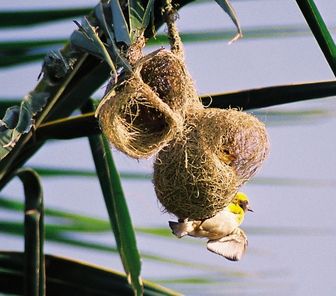Baya Weaver
Three geographical races are recognized. The nominate race philippinus is found through much of mainland India. The race burmanicus is found eastwards into Southeast Asia. A third race, travancoreensis is darker above and found in southwest India.

Original source: Own work
Author: Rajeev B (RawLife)
Permission: GNU Free Documentation License
The Baya Weaver is classified as Least Concern. Does not qualify for a more at risk category. Widespread and abundant taxa are included in this category.
The baya weaver of India, Sri Lanka, and Malaysia builds a flask-shaped nest of grass fibers, which is entered through a hollow tube on the underside. Mated pairs build nests in the same tree but the nests are not connected. The African masked weaver is found in Ethiopia. Mated pairs build single nests of grass, which are suspended from tree branches. Weaverbirds belong to the family Ploceidae. More
* Glossy Swiftlet steals nest materials from Baya Weaver II “I was out today to re-visit old locations in the... * Glossy Swiftlet steals nesting materials from Baya Weaver On 9th May 2009 Dato’ Dr Amar-Singh HSS was witness... * Baya Weavers do build odd-shaped nests An earlier post discussed the strange nests built probably... More
Baya Weaver is grain/seeds as we are all familiar with. There are reports of animal prey given to nestlings - caterpillars and grasshoppers, as well as winged termites, as reported by Madoc and Bromley in Wells (2007). “I have also seen and posted this on OBI. More
The Baya Weaver (Ploceus philippinus) is a weaverbird found across South and Southeast Asia. Flocks of these birds are found in grasslands, cultivated areas, scrub and secondary growth and they are best known for their hanging retort shaped nests woven from leaves. These nest colonies are usually found on thorny trees or palm fronds and the nests are often built near water or hanging over water where predators cannot reach easily. More
Baya Weaver (Male) Ploceus philippinus copyright Clement Francis M Baya Weaver (Female) Ploceus philippinus copyright Clement Francis M Baya Weaver (Female) Ploceus philippinus copyright Clement Francis M Baya Weaver Ploceus philippinus copyright J. M. More
Baya Weavers (Ploceus philippinus), pair at Kotaballappalli, Karnataka, India. Date 2006-10-06. Author: Rajeev B (http://commons.wikimedia.org/wiki/User:Rawlife). Permission is granted to copy, distribute and/or modify this document under the terms of the GNU Free Documentation License, Version 1.2 or any later version published by the Free Software Foundation; with no Invariant Sections, no Front-Cover Texts, and no Back-Cover Texts. A copy of the license is included in the section entitled "GNU Free Documentation License". More
* The Baya Weaver, a bird species found in South and Southeast Asia * The Finn's Baya, a bird species found in the Ganges valley of India Places - * Baya, Côte d'Ivoire, a village in Côte d'Ivoire * Baya, Ganassi, an inactive volcano in Lanao del Sur province, Philippines * Baya, Togo, a village in the Bassar Prefecture in the Kara More
The breeding season of the Baya Weavers is during the monsoons. The breeding condition is initiated by environmental characters such as day length and comes to an end after summer although this termination is not influenced by short day length as in temperate birds. They nest in colonies typically of up to 20-30, close to the source of food, nesting material and water. Baya Weavers are best known for the elaborately woven nests constructed by the males. More
The breeding season of the Baya Weavers is during the monsoons. They nest in colonies of upto 20-30, close to the source of food, nesting material and water. The nests are often built hanging over water. Baya Weavers are best known for their elaborately woven nests. These pendulous nests are retort shaped, with a central nesting chamber and a long vertical tube that leads to a side entrance to the chamber. More
The Baya Weaver (Ploceus philippinus) is a weaver found across South and Southeast Asia. They inhabit grassland, cultivated areas, scrub and secondary growths usually near fresh or brackish water. They are widespread and common within their distribution area but are prone to local seasonal movements. Despite their species name, they are not found in the Philippines. Three geographical races are recognized. The race philippinus is found through much of mainland India. The race burmanicus is found eastwards into Southeast Asia. More
Like the munias they are closely related to, Baya Weavers eat mainly grass seeds. They too have large conical beaks to deal with their food. They forage in flocks, in grass as well as on the ground. The flock flies in close formation, often performing complicated manouvres. Breeding: These dull looking birds have a most interesting breeding season (December-March). At this time, the males put on a brighter costume and they start to build their amazing nests. More

Original source: Flickr user NatureAtYourBackyard . Photo uploaded to commons by user ltshears
 Author: Flickr user NatureAtYourBackyard . Photo uploaded to commons by user ltshears
Author: Flickr user NatureAtYourBackyard . Photo uploaded to commons by user ltshears  Permission: Some rights reserved
Permission: Some rights reserved
Family : Ploceidae
Genus : Ploceus
Species : philippinus
Authority : (Linnaeus, 1766)

